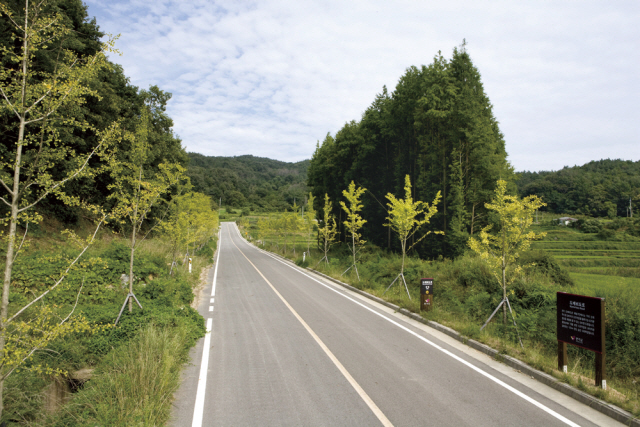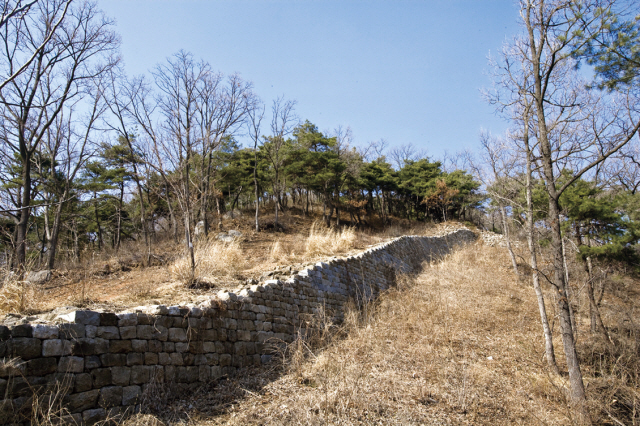About Chungnam
News
|Going on Around the Town|Trip to Yeongi-gun
Journey for Your Senses to Inland Chungnam
2011.10.19(수) | CNnews (![]() chungnamdo@korea.kr)
chungnamdo@korea.kr)
 |
||
| ▲ Located on the Yeongi gun, the road gradient illusion | ||
You can start your journey of Yeongi at Biam Buddhist Temple constructed 2,000 years ago. The last Buddhist temple of Baekje, one of Korea’s ancient kingdoms, Biam Buddhist Temple is renowned for its three-story stone pagoda, which was appointed as a cultural asset by Chungnam, and its splendid and detailed architectural style. Surrounded by quiet forests, the temple gives out the antique vibe of an old mountain temple. An about 850-year-old zelkova tree stands at the entrance, greeting visitors that come along.
Leaving the temple, you will see “Mystery Road,” the 150-meter section of the entrance road to the temple. With a 1.2m height difference between the highest and lowest point on the road, it creates an optical illusion that an object moves along from the lowest point to the highest point. You will come across tourists who try to do an experiment on the “Road Madness”
Near the temple there is “DweeUngBark Village,” Korea’s first “museum dedicated to traditional Korean pastes,” which have attracted attention with increasing interest in health in recent years. Entering the museum lying at the clean foot of Mt. Woonju, one of Yeongi’s celebrated mountains, you will be welcomed and surprised by about 1,700 crocks in nice rows. The crocks hold the traditional Korean soybean paste made of local beans. The town where the museum is located has long been recognized for its clean environments and has many macrobians. Presenting crock terraces of various themes including the gourd terrace over the ground of 43,000㎡, the museum is a very cozy place for visitors.
 |
||
| ▲ DweeUngBark village | ||
 |
||
| ▲ DweeUngbark village are well represented Korea's traditional beauty | ||
 |
||
 |
||
| ▲ Angler's paradise - gobok Reservoir | ||
There is a famous waterside tourist destination in Yeongi-gun, namely Gobok Reservoir appointed as a provincial park. Enjoying popularity among anglers, the reservoir particularly excels in beauty in spring when the area is covered with cherry blossoms, and in autumn when there are layers of serene mists. Its freshwater volume amounts to 1,949㎢. There is a 2.2km road section that runs from east to west, and the road section has a beautiful waterside landscape at its both ends. You can experience a spectacular walking trip along the circulatory route around the lake. There are a sculpture park and observatory in the vicinity of the park as well as an outdoor swimming pool in the upper stream area.
 |
||
The mountain fortress surrounding Mt. Woonju of Yeongi-gun is a valuable cultural asset that tells its history. Mt. Woonju is its highest mountain at a height of 460 meters above sea level. The mountain fortress is comprised of the external section that runs 3,210 meters and the internal one that runs 1,230 meters. Built during Baekje, one of Korea’s ancient kingdoms, the mountain fortress is believed to have been Baekje’s last battlefield where its people fought for its revival after its fall. Surrounded by basin-type geographical features and beautiful landscape, the
 |
||
| ▲ 1000 years of proud history and beautiful scenery in the stone wall is a valuable tourism resource | ||
 |
||
Yeongi-gun has a museum by the name of Textbooks Museum, where you can take an overall look at the history of Korean textbooks. The museum presents a wide collection of various textbooks from the period of Three Kingdoms and Goryeo to the contemporary curriculums by historical period. It is comprised of different halls that show the replicas of Korean classrooms for a peek at the educational environment of Korea, the process of making a textbook, a collection of world textbooks, a collection of North Korean textbooks, and future textbooks. The museum holds educational significance as the visitors can learn about the curriculums for Korean students while looking at textbooks that are part of the basic materials of Korean education.




